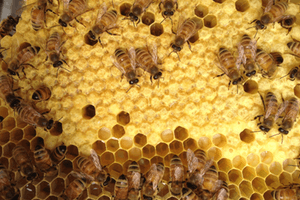- All-In-One Beekeeping for the Bees
- +1-608-728-8233
- info@beepods.com
Native Bees: How Your Colony Might Impact Them, and How You Can Support Them!

A leafcutter bee collects pieces of a leaf. Leafcutters line their nest cells with leaves, the behavior that gives them their name.

Long before honey bees were introduced to North America in the 1600s, native (or wild) bees were doing their thing across the continent. While honey bees make important contributions to our agricultural system, native bees play an equally, if not bigger role in pollination.
Today, we’re taking a look at how honey bees impact native bees, for better or for worse. I’ll leave you with some tips for how all of us can support native bees.
How Native Bees Differ from Honey Bees
Native bees are much different than the social, honey-making bees we know and love. Here’s how:
- They Fly Solo: Unlike honey bees, who lean on their colonies for survival, most native bees are solitary and self-sufficient – aside from getting together to mate.
- They Create Nests: Many native bee species, like bumblebees, are ground nesters who build their homes with dirt. Others, like mason bees, are cavity nesters who make their nests in small holes found in dead wood or stems.
- They’re Easy Going: Without a hive full of honey, there isn’t much for native bees to defend or get aggressive about. Many don’t even have stingers!
- They’re Picky Pollinators: Some native bees, called “specialists,” prefer specific plants, so much that they’ve evolved so their reproductive cycles align with when those plants bloom.
Native Bees and Honey Bees Co-existing in Harmony (Mostly)
Native bees and honey bees often get along just fine as neighbors. Research shows that crops are much better in fields where both types of bee live vs. areas where only one resides. Their foraging behaviors differ, with honey bees enjoying a wide variety of blooming plants, and native bees tending to be a bit more selective – remember, those native specialist bees are choosy! Together, they contribute to more productive pollinating activity.
That said, the different species don’t exactly hang out. Native bees typically keep their distance from honey bees. This might be because honey bees tend to be territorial and become aggressive if they perceive a threat or predator.
How Honey Bees Can Be Harmful to Native Bees
Competing for Forage Resources
When diverse forage is abundant, sure, honey bees and native bees can co-exist nicely. But, when forage sources are limited, the bees become competitors.
Because honey bees enjoy many plants and come in large numbers, they sometimes hog plants that a specialist native bee might count on. This can lead to native bees switching to less-rewarding plants to survive, which can result in poor reproductive success and shorter life spans.
Disease and Parasite Spread Among Species
Another challenge to honey bees and native bees living near each other is the potential to exchange diseases. Bees leave behind feces when they visit flowers and plants, which can contain pathogens or parasites, and can be picked up by other bees of any species.
Through shared forage, honey bees introduce new viruses to wild bees. They also exacerbate existing infections and parasites among their colonies and pass worsened diseases to wild bees. Viruses like deformed wing virus (DWV), black queen cell virus, and Nosema easily travel between species and pose a severe threat to native bees.
One study examined black queen cell virus spread between kept bees and native species. Researchers confirmed that 90% of bumblebees collected near an infected apiary picked up the virus. This goes to show just how easily the species can transmit infections to each other.
Save (All) The Bees

A miner bee stops to rest on a leaf. Like their name suggests, miner bees lay their eggs in tunnels they dig underground.
Native bees are important pollinators, and we should do what we can to protect them.
Creating a pollinator-friendly environment in your own backyard gives native bee species diverse forage sources they’ll love. Check out our tips for naturalizing your yard, and steps you can take to attract native bees. These efforts can help reduce competition between kept bees and native ones.
Consider adding a few native bee-friendly elements to your yard. Mason and leafcutter bees love bee houses, which can be made with some simple woodwork. Bare earth patches are great for ground-nesting bees. Cavity nesting bees will create their homes in provided tree stumps or logs in no time.
Beekeepers can support native bees, too! Positioning your bees near a variety of habitats, like gardens, wooded areas, and orchards, offers all bees a great resource mix. Pay attention to your hive health, and do what you can to help manage disease and reduce spread among species.
Conclusion
While honey bees and native bees might not be nature’s best friends, each are valued members of the pollinator community. By doing what we can to keep our bees healthy, and providing a diverse forage landscape for all bees, we can help minimize any negative impacts on native bees.
Kanoe Riedel
Latest posts by Kanoe Riedel (see all)
- This Spring, Don’t Forget Why Bees Are So Important to Our Environment - March 26, 2021
- 11 Awesome Uses for Your Stored Honeycomb - March 2, 2021
- How the Right Beekeeping Equipment Makes Inspections Better for Beekeepers and Bees - February 12, 2021



